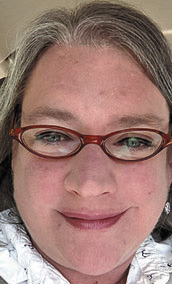Pop Goes The World Joann Ware
It was a typically gray January afternoon that day in 2008 when the call came in from someone at WSLS. “Hi, we’re hearing that human remains have been found at the construction site of the new Courthouse parking deck. Have you heard anything about that?” the voice queried. “No,” I said. “But thanks for the news tip!”
Our investigative reporter at the time, Roberta Anderson, was immediately dispatched to the site.
A crime scene was ruled out because of the presence of a coffin nail in the soil. This was a legitimate grave site. The bones were determined to be those of a young African-American woman. At an estimated height of 5’7”, she was tall for her time. Her teeth revealed years of malnutrition and disease. Then-Lexington Police Chief Steve Crowder gave her the name Ancient Jane. City council member Marylin Alexander said a more fitting name would be Miss Jane, as courtesy titles are a sign of respect in the African- American community.
From the moment her bones saw the light of day after being buried for so long, there was a great deal of interest in this woman and the life she led. Was she a slave? Did she have a family? Was she related to anyone living in the community today?
One thing is pretty certain – in her short time on earth, she probably never imagined that there would be so much interest in her. Or that she would have a reburial attended by members of Lexington City Council, the mayor, and Washington and Lee University and Virginia Military Institute professors.
I covered her funeral at Evergreen Cemetery for the paper in May 2019. I’m an emotional person and a sob caught in my throat as I saw her coffin brought into the cemetery on a carriage drawn by two majestic black Percherons. She probably never in her life imagined such a grand home going for herself.
Before her reinterment, one of her molars was sent to a lab in California for testing and those results were recently revealed. There weren’t a lot of surprises. It was confirmed that she was a female, approximately 1723, with her roots in West African countries associated with the slave trade. Those who attended the presentation clearly wanted to know more about the lady. During the question and answer period, people wanted to know, will it ever be possible to determine that she’s blood kin to modern day Lexington residents?
In the time I’ve been covering Miss Jane, I feel I have developed a kinship with her, a familial protectiveness.
I imagine her days were long. She probably woke before the members of the household and made minimal noise as she changed into her daytime clothes and wrapped her hair by the light of a single hurricane lantern. Her sleeping quarters were probably cramped and she no doubt savored the moments in the early morning before the others stirred.
If she worked in the home, she was tasked with keeping the house clean or helped out in the kitchen. The kitchen was detached from the house, as kitchen fires often turned wood frame homes to cinders back then. She whistled as she carried the food from the kitchen to the house so that the family she was serving would know that she wasn’t tasting the food or putting poison in it.
I sometimes envision her cutting an impressively regal form as she walked in downtown Lexington heads above the other residents. Her clothes were probably very plain and she most likely covered her hair with a muslin kerchief. Did she sometimes look at the well-heeled white women in town in their Regencyera frocks and feel a bit of jealousy that their clothes came from far-off places like New York and Paris? Did she wonder what their giggles were about and think how wonderful it would be to have something frivolous to laugh about? Did she envy their bonnets in colors of periwinkle and rose to protect them from the sun?
Since African-Americans were not allowed to attend school, she could not read the street signs or the names of the shops downtown. When sent on errands, she was probably told to look for a sign with a pig or one with a needle and thread.
She fell ill from something that is most likely curable today. When communicable illnesses struck a community, it was almost impossible to avoid becoming a victim of whatever was going around. I imagine her access to healthcare was limited to whatever herbs could be harvested from the kitchen garden, boiled and made into a poultice.
On her final day on this earth, the hurricane lamp was positioned by her head as she drew her last breath. The light was then extinguished and mournful cries filled the quarters as her face was covered by a sheet.
She was buried in a pine coffin. Ropes lowered her body into the ground. Dirt landed in thuds on her coffin. When her coffin was covered, the mourners moved away, went back to their homes, their lives, their enslavement.
She rested there under the groundcover of brilliant periwinkle until she emerged from the accident of an excavator’s blade disturbing her grave, ready to tell her story, with many chapters yet to be written.

.jpg)


